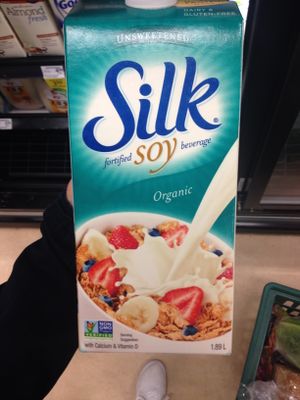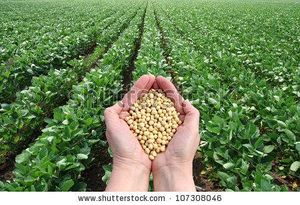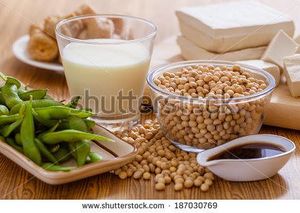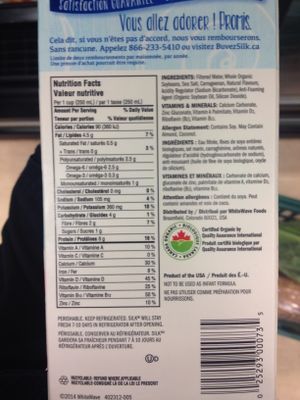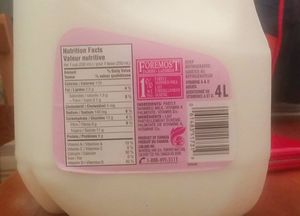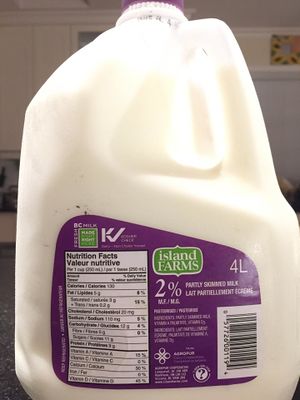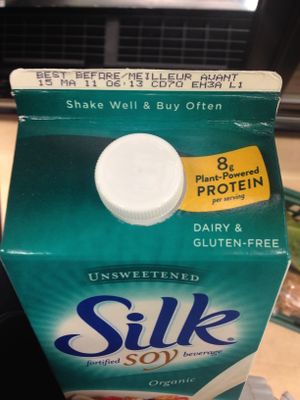Course:FNH200/2014w Team19 FortifiedFoods
Abstract
Fortification and Health Inspection of Milk and Soy Milk
FNH 250-003
Rachelyn Ritchie, Michelle Kim, Aspen Dirk, Akanksha Sharma
Soy and dairy may be thought of by the average consumer as one and the same due to their similar uses. On the other hand, soy may be distinguished in the mind of the consumer by its controversial characteristic of containing estrogen. This project aimed to discover the ways in which soy milk is a suitable replacement for milk, the potential health risks/benefits of soy and the nutritional necessity for dairy and soy milk fortification.Why are dairy milk products fortified in the first place? During the processing of dairy products, the fat soluble vitamins leave with the milk fat (that is because most of the milk products we drink are reduced-fat.) Vitamins A and D are found in milk abundantly and are very important; Vitamin A contributes to eye health, bone health and cell tissues6. VItamin D acts as a co-factor in absorbing calcium in the body3. Vitamin C however is not found naturally in milk, but is required for good health. It aids in the strengthening and building of many structural components in the body as well as the absorption of iron3. So, why Is the fortification of dairy and soy milk necessary? The fact that milk has naturally occurring vitamins and minerals that the body can’t produce on its own, makes milk an important component of the diet. Since the milk consumers drink is not natural but processed, not all the vitamins are present post -processing. Therefore, regulations have been developed in order to ensure that consumers have access to important nutrients through milk. Soy, being a milk alternative is not required to be fortified. Soy milk is a respected alternative for dairy milk and has no negative health effects, rather many benefits to health and disease prevention.
Q&A - Exam
Q1: Why is the fortification of milk necessary? What about for Soymilk?
A: Processing milk requires removing the fat from the raw milk; this consequently removes the fat soluble vitamins A and D. The end product if milk that does not have many nutrients in it, therefore we need to put it back into the milk; restoration. There is no Vitamin C in the milk originally, but due to public need for this nutrient, it gets added into milk; fortification. B-vitamins are not mandatorily restored in milk because they are water soluble vitamins and therefore are retained in the milk even after processing.
In terms of soymilk, it is not a mandatory regulation to add those vitamins mentioned previously. However, Soymilk does not contain Vitamins A, D, C and B naturally and manufacturers have the choice whether to fortify it. This can be a problem if people choose to drink Soymilk as an alternative to milk.
Q2: What are the various health effects of soy, specifically in regard to the growth or suppression of cancerous tumors?
Soybean is a legume with many essential micronutrients like manganese, selenium, copper, manganese, potassium, phosphorus, iron, calcium, magnesium, vitamin B6, folate, riboflavin, thiamin and vitamin K. They are also a good source of plant based protein, however a few processing techniques might denature them.
Based on studies conducted over the past few years, diets rich in soy have shown to be at a lower risk for breast cancer and removal of soy has led to the increased tumor size and susceptibility for developing a cancerous tumor. A few studies have also shown links between a soy-rich diet and low incidence of breast cancer in females and prostate cancer in males.
Introduction
In a time where choosing a variety of food sources is both favored and encouraged, traditional options for essential nutrients, such as those in Milk, are being replaced with the likes of Soy Milk. At the supermarket, people are constantly bombarded with variety in their food selections, with each one advertising specific health claims. For Soy Milk, there is an extensive process in order for it to be up to Canadian Standards. Similarly, there is a unique and regulated process by which milk from cows turn into the different milk products sold in the supermarket.
With the variety of options available to consumers, it is important to understand both the processing and fortification of soy milk, as well as the potential health benefits and risks that go along with choosing other milk alternatives. The bioavailability of calcium in soy milk compared to cow’s milk has been questioned, and there is debate on if the alternative provides this essential nutrient as well as other nutrients the body needs like Vitamins A, C and D. It is an important question to answer, because with the growing popularity of soy milk, especially in North America, consumers want to be certain that they are receiving the adequate daily values of calcium from their foods. Another reason the question of the nutrient adequacy of Soy milk is important to explore is the growing issue of lactose intolerance that inhibits the digestion of lactose and therefore milk products. Also, the integrity of commercial products could be called into question if we are not absorbing all of the vitamins (especially calcium) that the products claims to contain, due to fortification processes. This paper will explore the differences between dairy and soy and conclude why these products necessitate fortification, which controversies around soy are justified, and the regulations governing each of these products.
Origins
Soy Milk comes from soybeans, a species of legumes native to East Asia, where the first traces of soymilk production originated. The beans are in pods on the leaves of the plant, ranging from 2 to 4 seeds. Soybeans are considered to be a sources of complete protein; a protein that contains significant amounts of all the essential amino acids. When raw, they are both a high source of protein and soluble carbohydrate at 36.5 grams and 30.0 grams per 100 grams, respectively (according to Stats Canada). Without any fortification, there is 277 milligrams of Calcium per 100 grams of soybean, however depending on the fortification, this numbers can increase up to 6 times the original value.
Drying
Once the soybeans have been harvested, they are ready to be dried for a longer storage life. This can happen in several different types of high – or – low temperature dryers. The most common is tray drying and modified atmosphere packaging. If handled too roughly or dried at a heat greater than 140°F, the soybeans can be irreversibly damaged. For high temperature drying, the heat must be contained between 130°F - 140°F for less than 30 minutes and be monitored as soybeans dry rapidly. Low temperature drying is a bit longer process, but yields a more natural product with the process lasing up to six weeks. Once dehydration has occurred, dried soybeans can last up to 10 years under proper conditions (kept in a cool, dry place).
Extraction
Once harvested and shucked, the extraction process of soybeans to soy milk is fairly straightforward and simple. In fact, it is so simple that many people make their own soy milk (without the fortification) within their own home. For 125 grams of whole, dried soy beans, it is possible to create 1 liter of soy milk. First, the beans must soak in water for 10 to 16 hours. This is to rehydrate the beans via osmosis and reversing the shrinkage that occurred during the dehydration process. Next, heating the strained soybeans for 2 minutes in boiling water will destroy the enzymes which are responsible for the beany-flavour that consumers do not want., then again straining the contents.
By using a blender to grind the soaked soybeans and 1 liter of water, the juice and oils that were once within the pellets are now dispersed in liquid. Sieve the mixture through a cheesecloth to recover the “soy milk,” while discarding the remains on top. Then, the liquid must be heated again to destroy any harmful bacteria or enzymes that might have survive the previous steps. Once boiling, it must be continuously stirred for 10 to 15 minutes. After cooling, the soy milk is ready and can be kept in the fridge for another 3 days or frozen at 0°F for up to 90 days.
Different Types of Fortification
Fortification of soy milk is optional. On it’s own, soy milk only has a third of the calcium available when compared to cow’s milk, and so it must be fortified in order to meet the Canadian Standard of Fortification. There are three popular methods that are used to fortify soy milk with calcium; Tricalcium Phosphate, Calcium Carbonate, and Vegetable Calcium from seaweed.
Tricalcium Phosphate
Tricalcium Phosphate is found naturally in cow’s milk and in other inorganic sources such as Whitlockite, a mineral rock. It has a phosphate body with three calcium molecules attached, making it one of the most calcium concentrated of the calcium phosphates. For nutrition supplementation, Tricalcium Phosphate is grinded down into a salt like substance and then added to a liquid, such as soy milk. In terms of bioavailability, it is the least efficient and the human body does not absorb all of the supplement that was mixed in with the liquid (Zhao et al. 2005).
Calcium Carbonate
The most popular method of fortification is Calcium Carbonate, which has three main components; oxygen, carbon, and calcium. All three of these compounds are found naturally in the body, making it the most absorbed supplement of calcium fortification. It is also one of the cheapest alternatives for calcium alternatives, which can either be taken as a pill or a refined salt/powder in other food, such as soy milk. One study has shown that, if mixed properly, Calcium Carbonate has the same bioavailability for calcium when compared to cow’s milk (Zhao et al. 2005). This means that soy milk that has been fortified with this supplement, it provides the human body with the same amount of calcium as cow’s milk, but without any of the other nutrients, such as lactose.
Lithothamnium Calcareum
The common name for Lithothamnium Calcareum is Algalithe, which is a red seaweed that grows in thirty meter deep sea water. It has large pores, which make it able to absorb calcium from the water and retain it in order to continue living. For supplementation, we gather the red seaweed, let it dry through sun drying, and then crush it into a fine salt. From there, it can be added to soy milk as a calcium fortifier. Since soy milk has a pH of 7.1, it does not dissolve. Instead, the salt remains suspended in the liquid and may create a thin film that sits on top of the milk. In order for it to be absorbed, the calcium-salt film must be shaken or stirred into the liquid and then consumed. When it comes to bioavailability, only half of the consumed calcium actually get absorbed into the body.
Unfortunately, not all of the added supplements get absorbed into the body. In fact, if the container is not shaken before consumption to better immerse the salts into the liquid, only 30% of the available calcium is absorbed into the body (Heaney & Rafferty 2006). Once being shaken, that number goes up to only 59% on average (Heaney et al., 2000). If a person wanted to have the minimum dose of calcium, they must consume roughly 1.7 times more soy milk than cow’s milk in order to achieve that goal.
Fortification Policies of Soy Milk
According to the Food and Drugs Act, companies may manufacture soy beverages without any fortification if they so wish. If they do choose to fortify, there are two different levels of nutrients that must be equivalent to those found in cow’s milk. They are as follows:
- To fortify with 6 nutrients - companies must add vitamin A, vitamin D, vitamin B12, riboflavin, calcium and zinc.
- To fortify with 15 nutrients - processors must add vitamin A, vitamin D, vitamin B12, riboflavin, calcium, zinc, vitamin B6, vitamin C, thiamin, niacin, folacin, pantothenic acid, phosphorus, potassium and magnesium.
Regulations of Milk in Canada
In regards to Canada, there is a detailed and specific list of regulations for the addition of minerals and vitamins into dairy products. The majority of the fortification/additive regulations for all types of food outlined in Canada’s Food and Drug Regulations (FDR) has to do with complying to the rules for certain health and advertising claims. Meaning a claim can only be made if it falls within the set boundaries stated in the FDR. For example, manufacturers that wish to claim their product to be fat-free as a consumer hook, must adhere to a certain percentage or certain weight of fat per product in order to legally make this claim. (Hammond, 2015). The biggest difference, however, is found in the regulations for fortification/additives of dairy products. The restoration of dairy products is promoted by Canada’s government by requiring that Vitamins A and D be added into fluid milk by law, as well as fortification of Vitamin C. More specifically, Vitamin D must be added to all forms of milk while only skim and partly skimmed milk also require the addition of Vitamin A. The legal requirements also hold for the addition of evaporated and powdered milk, and the only specific requirement is the addition of Vitamin C to evaporated milk. Similarly, milk alternatives that have a plant origin (in this case the subject is soy), also require fortification of Vitamin D. The reason for these mandatory regulations will be elaborated on further in this section.
Firstly, in order to get a good understanding of the need for the regulations for fortification of dairy and soy products, a detailed view of the requirements must be laid out first. As found in the Food and Drug Regulations, the amount of the specific vitamins required is dependent on the type of milk product. For milk and whole milk, the recommended daily intake (RDI) must be met by having 300-400 IU (International units) of Vitamin D. Skim milk requires the same amount of VItamin D, as well as an RDI of 1200-2500 IU of Vitamin A. These same requirements are also applied to partly skimmed milk. Going more in depth to these regulations, the requirements for Vitamin D in milk also apply to the powdered and sterilized milk. The regulations for skim milk are extended to skim and partly skimmed milk products that have added solids as well as skim milk powder. The required addition of Vitamin C implemented to evaporated milk only. Evaporated whole, skim and partly skimmed milk require the same RDI amounts for Vitamin D and A, as well as an RDI range of 60-75 IU of Vitamin C. In addition to these Nutritional requirements, the process by which milk products are fortified also must adhere to its respective regulations. Some of which include at what point of milk processing that the nutrients can be added as well as inspection of the content of vitamins added.(Canadian Food Inspection Agency [CFIA], 2013). While Vitamins D, A and C are added nutrients to milk by regulation, the addition of B Vitamins (particularly Thiamine and Riboflavin) is not a mandatory addition. This is due to the fact that milk naturally contains sufficient amounts of these vitamins, and thus does not require addition fortification. (Hammond, Energy Metabolism, 2015).
Originally the fortification of soy milk had not been much of a requirement. It has been proposed strongly now, however, that soy milk (as well as other plant-based milk products) be fortified similarly to those of their milk counterparts. This leads into the explanation of why all these regulations are needed. (J, 1997)
The use of additives in foods are mostly to enhance the nutrient content of a food product as an advertising gimmick. As mentioned before, there is a big difference in the fortification of milk and soy products, as they promote the addition of vitamins. The addition of Vitamin D to all milk products has been put into regulation since 1965, and the addition of Vitamins A and C were added afterwards. These regulations were in response to increasing cases of conditions and diseases that occurred from deficiencies of certain vitamins and minerals. The Canadian Food Inspection Agency (CFIA) specifically outlines the many health functions of vitamins A, C and D showing how important adequate amounts of these micronutrients are. Though they can be found naturally in the milk products, many stages of processing remove the vitamins and produce an end product that has extremely low amounts of nutrients. In the case of Vitamin A for example, it is removed when the fat from milk is removed when making skim and partly skimmed milk. Vitamin D, however, can be replenished from chemical reactions with the UV rays from the sun, as well as other external sources (CFIA, 2013). However this is a problem as a majority of the Canadian population does not receive enough Vitamin D. (Calvo, Whiting and Barton, 2004). It is common knowledge that Vitamin C is found in a large variety of fresh fruits and vegetables, so the regulations of Vitamin C in evaporated milk is questionable; those regulations were primarily to incorporate sufficient vitamin C to communities who were unable to access it via natural sources (i.e fresh fruits and vegetables). (CFIA, 2013). So far, the need for regulations had to do with meeting the nutrient needs for a population in order to prevent deficiency symptoms. There is another contrasting side to why regulations are needed, and that is to prevent possibility over intoxication of these nutrients. The regulations help to guarantee that consuming these milk and soy ingredients will provide enough nutrients to curb deficiency and limit over-supplementation. (J, 1997).
Health Effects of Soy
In order to determine the health effects of soy, we will be looking at a meta analysis and a case study. Soy isoflavones will be the main topic of discussion. They are non-steroidal estrogens called phytoestrogens, and are found in soybeans and soy-based foods. The introduction of one meta-analysis forewarns that identifying the role of soy isoflavones on prevention of disease is extremely difficult due to the “ interplay of lifestyle factors, genetics and other confounding variables.” (Setchell, 1998). Despite the lack of case studies covering the duration of peoples’ lives, there is sufficient evidence based on animal studies, differences in peoples of varying geographical locations etc. to make informative links regarding soy and some of its health effects. I will begin with a meta-analysis done by Dr. Kenneth Setchell; “Phytoestrogens: the biochemistry, physiology, and implications for human health of soy isoflavones.” Phytoestrogen content is found in highest density in soy protein. It was found that to achieve any significant biological effect in humans, 30-50 mg of phytoestrogens must be consumed a day. Firstly, we will recognize that after consuming soy proteins, estrogen is seen in “several magnitudes of order higher” than endogenous estrogen (Setchell, 1998). This is the primary source of controversy regarding soy; what is being done with the surplus of estrogen in the body due to soy consumption? With the help of case studies and meta analysis we will attempt to give answers as to the benefits and potential harmful effects of soy.
One of the biggest findings was regarding breast cancer tumour growth. A study done on rats using chemically induced breast cancer showed that a diet high in soy proteins significantly reduced tumour growth. Furthermore, the effects were reversed when soy protein was removed from the diet. Rats exposed to phytoestrogens from in-vitro were more resistant to tumour growth. (Setchell, 1998) This may explain the low occurrences of breast cancer in eastern Asian countries that soy is native to. The amount of soy protein consumed by the rats that showed suppressed tumour formation is considered to be a manageable amount of dietary soy protein intake for humans. Another study however showed that “. . .genistein, a major soy isoflavone stimulated (breast) tumor growth at low concentrations” ( Kwon, Y. 2014).
One concern about dietary estrogen is the competitive inhibition with the necessary hormone estradiol potentially affecting female reproductive development. This concern was common before the discovery of different estrogen receptors, which makes the concern devoid. Another question is how soy affects young males and their reproductive development, which is piloted by testosterone. A study published by the endocrine society involved rats exposed neonatally to a soy containing diet. The results were potential reduced testes size, reduced body weight, early spermatogenesis and high FSH levels (N. Atanassova et al., 2000). Overall, these results are benign.
It hasn’t been determined exactly which benefits of soy are hormone related or not, since not all bioactivity of soy isoflavones is hormonal action. Depending on the composition of the isoflavone, its’ biological role varies. This emphasizes the principle of variety in the diet. Soy milks (lower in isoflavones) combined with tofu ( higher in soy isoflavones) will lend to a consumption of all the important types of phytoestrogens. Soy isoflavones are also shown to have antioxidant, anti-proliferative, and antiangiogenic properties. These can contribute to cancer prevention, and also prevention of atherosclerosis (heart disease) (N. Atanassova et al., 2000). Overall, it seems that a soy containing diet is a good thing for human health, not only due to isoflavone content but also because soybeans contains all 9 essential amino acids. The body needs amino acids for building blocks of body tissues, hormones and enzyme production and function. The AMDR recommendation for protein is 10-35% of energy intake /per day.
The body needs dietary vitamins such as A, C, D, B12, riboflavin and minerals such as calcium because they cannot be produced in the body. Vitamins A and C are both antioxidants in the body, which combat damaging free radicals. Vitamin A is important for vision, growth, development, reproduction and health of mucous membranes, to name a few of its roles. Vitamin A is naturally occurring in dairy milk, however since it is a fat-soluble vitamin, the concentration goes down as the milk fat decreases until there is zero vitamin A (non-fat milk). Another essential vitamin is vitamin D. It is needed to form the hormone calcitriol, which helps to increase the uptake of calcium from the gastrointestinal tract into the blood, and from there to the bones. Without calcium for a long period of time, bones can become weak and softened. The fortification of fresh milk with vitamin D has been recognized as eliminating rickets in milk drinking children. (FDA, 2015).
The necessity for fortification is this; to replace the naturally occurring vitamins that have been removed along with the milk fat and to provide concurrent nutrients (vitamin D) to aid in absorption of calcium found in milk. Fortification of soy includes riboflavin and thiamin since these B-vitamins are found naturally in milk and soy is a milk alternative. These two B-vitamins act as co-enzymes in the body helping to release energy from macronutrients and synthesize reactions. (Hammond, 2015). Case studies:
Case Studies
Soy Proteins, Isoflavones and Cardiovascular Health
An American Heart Association Science Advisory for Professionals From the Nutrition Committee.
By: Frank M. Sacks, MD; Alice Lichtenstein, DSc; Linda Van Horn, PhD, RD; William Harris, PhD; Penny Kris-Etherton, PhD; Mary Winston, ED; for the American Heart Association Nutrition Committee.
Abstract
Soy protein and isoflavones (phytoestrogens) have gained considerable attention for their potential role in improving risk factors for cardiovascular disease. This scientific advisory assesses the more recent work published on soy protein and its component isoflavones. In the majority of 22 randomized trials, isolated soy protein with isoflavones, as compared with milk or other proteins, decreased LDL cholesterol concentrations; the average effect was +/-3%. This reduction is very small relative to the large amount of soy protein tested in these studies, averaging 50 g, about half the usual total daily protein intake. No significant effects on HDL cholesterol, triglycerides, lipoprotein(a), or blood pressure were evident. Among 19 studies of soy isoflavones, the average effect on LDL cholesterol and other lipid risk factors was nil. Soy protein and isoflavones have not been shown to lessen vasomotor symptoms of menopause, and results are mixed with regard to soy’s ability to slow postmenopausal bone loss. The efficacy and safety of soy isoflavones for preventing or treating cancer of the breast, endometrium, and prostate are not established; evidence from clinical trials is meager and cautionary with regard to a possible adverse effect. For this reason, use of isoflavone supplements in food or pills is not recommended. Thus, earlier research indicating that soy protein has clinically important favorable effects as compared with other proteins has not been confirmed. In contrast, many soy products should be beneficial to cardiovascular and overall health because of their high content of polyunsaturated fats, fiber, vitamins, and minerals and low content of saturated fat.
Bioavailability of the Calcium in Fortified Soy Imitation Milk, with some Observations on Method
By: Robert P Heaney, M Susan Dowell, Karen Rafferty, and June Bierman.
Background: Calcium-fortified soy milk is growing in popularity, particularly among vegetarians, but the bioavailability of its calcium was not previously known. Additionally, the validity of isotopic labeling methods for fortified liquid products had not been established.
Objectives: The objectives of this study were to compare the bioavailability of the calcium in fortified soy milk with that of calcium in cow milk and to evaluate the method of labeling soy milk for bioavailability testing.
Results: Calcium from intrinsically labeled soy milk was absorbed at only 75% the efficiency of calcium from cow milk. Extrinsic labeling of soy milk did not produce uniform tracer distribution throughout the liquid and solid phases and resulted in a 50% overestimate of true absorbability.
Conclusion: Calcium-fortified soy milk does not constitute a calcium source comparable to cow milk, and extrinsic labeling of such calcium particulate suspensions does not produce the uniform tracer distribution needed for bioavailability testing. Hence, intrinsic labeling of the fortificant is required for such liquid suspensions.
Consumer Perception of Soy and Dairy Products: A Cross Cultural Study
By: V.S. Jones, M.A. Drake, R. Harding and B. Kuhn-Sherlock
Abstract
Soy and dairy are the two main sources of protein that are used in specialized products such as sports bars and beverages. Historically, New Zealanders have consumed mainly dairy products, whereas American consumers have been exposed to both soy and dairy. The purpose of this research was to collect consumer views and opinions from New Zealand (NZ) and U.S. consumers about the health benefits and product claims associated with soy and dairy products and to determine if there were any cross-cultural differences. Consumers from the U.S.A. and NZ answered a usage and attitude questionnaire and completed a conjoint analysis survey on their general knowledge and perception of the health benefits of soy and dairy products and the differences between these products. Both groups of consumers associated specific health claims with each protein source. There were minimal differences between U.S. and NZ consumers in their knowledge and perception of soy and dairy products; however, NZ consumers had a greater preference for dairy, whereas U.S. consumers did not differentiate their choice of protein source as clearly.
Future Research
The fact that some of the vitamins, especially calcium, are not suspended into the liquid is a problem with fortified soy products. The majority of the people who consume soy milk are generally those who are lactose intolerant or choose to consume a vegetarian diet. They shouldn’t have to worry about if they are truly getting enough of their daily calcium because not all of the additives were absorbed or not. One potential reason for this lack of research could be the assumption that it is already good enough for the average healthy individual. If possible, companies should work towards developing a type of calcium fortification which can be absorbed completely into the liquid and further into the body. This would greatly benefit the health those consumers who choose to purchase the product.
Given the fact that there are no standard regulations in Canada which requires soymilk manufacturers to fortify their products is an issue. This could be because soymilk is still a relatively new product in Canada, and that the DRI of each vitamin and mineral is almost constantly under debate. Soymilk is a great alternative for those who are lactose intolerant or vegan, and yet they may not always be getting the essential vitamins and minerals they believe they are consuming if the company chooses not to reinforce their product. If the Canadian Government were to look into the cost and health benefits of regulation of soymilk, then those who do choose to consume this dairy alternative would be appreciative.
Conclusion
Dairy products have been a part of the human diet since ages past. However in the recent years, with growing intolerance to the milk sugar lactose and increasing prevalence of plant based diets, alternatives to milk have been in demand; soy milk being one of them. As the report flows through the origin of soy and its uses, we advance to the extraction of soy, the process of making soy milk and then examine its health effects. Dairy milk contains very important micronutrients which are lost to a certain degree during processing. Other nutrients in milk are more available to the body if the proper vitamins are there to interact as co-factors. Here we have the necessity of fortification; to replenish lost nutrients and to increase bioavailability of those already present. These fortification techniques are controlled by strict guidelines regulated by the Canadian Food Inspection Agency (CFIA) and other government agencies. Dairy milk has proven to be a safe and nutritious option for the consumer for decades. However for those lactose intolerant consumers and those who prefer a plant based diet, fortified soy milk is a healthy and safe alternative.
Video
References
1. Calvo, S. Mona., Whiting, J. Susan., and Barton, N. Curtis. (2004). Vitamin D fortification in the United States and Canada: current status and data needs. The American Journal of Clinical Nutrition, 80. Retreived from http://ajcn.nutrition.org/content/80/6/1710S.full
2. Christopher D. Gardner PhD, Mark Messina PhD, Alexandre Kiazand MD, Jennifer L. Morris PhD & Adrian A. Franke PhD pages 669-677. Received: 30 Sep 2006. Accepted: 2 May 2007. Published online: 14 Jun 2013. DOI : 10.1080/07315724.2007.10719646
3. Dairy Vitamin Addition: Manuals/Inspection Procedures. (2013). Canadian Food Inspection Agency. Retrieved from http://www.inspection.gc.ca/food/dairy-products/manuals-inspection-procedures/dairy-vitamin-addition/eng/1378179097522/1378180040706
4. Frank M. Sacks, MD; Alice Lichtenstein, DSc; Linda Van Horn, PhD, RD; William Harris, PhD;Penny Kris-Etherton, PhD; Mary Winston, ED; for the American Heart Association Nutrition Committee. “Soy proteins, isoflavones and cardiovascular health.” AHA Science Advisory. Circulation (2006); 113: 1034-1044. Published online before print January 17, 2006, doi: 10.1161/CIRCULATIONAHA.106.171052
5. Kwon, Y. (2014). Effect of soy isoflavones on the growth of human breast tumors: findings from preclinical studies. Food Sci Nutr 2014; 142; 613-622
6. Hammond, Gail. (2015). Energy Metabolism Slides. UBC.
7. Hammond, Gail. (2015). Overview and Diet Quality Notes. UBC.
8. Health Canada. (1997). Food and Drugs Act and Regulation, 1981.
9. Heaney RP and Rafferty K. (2006). The settling problem in calcium-based soybean drinks. (Letter) J Am Diet Assoc 2006;11:1753-1754.
10. Heaney RP et al. (2005). Not all calcium-fortified beverages are equal. Nutr Today 2005;40:39-44. Heaney RP et al. (2000). Bioavailability of the calcium in fortified soy imitation milk, with some observations on method. Am J Clin Nutr 2000; 71:1166-69.
11. N. Atanassova, C. McKinnell, K. J. Turner, M. Walker, J. S. Fisher, M. Morley, M. R. Millar, N. P. Groome, and R. M. Sharpe. “Comparative Effects of Neonatal Exposure of Male Rats to Potent and Weak (Environmental) Estrogens on Spermatogenesis at Puberty and the Relationship to Adult Testis Size and Fertility: Evidence for Stimulatory Effects of Low Estrogen Levels.” Endocrinology (2000): 141:10, pg. 3898-3907. Web 8 March 2015.
12. Setchell, Kenneth. “Phytoestrogens: the biochemistry, physiology, and implications for human health of soy isoflavones.” The American Journal of Clinical Nutrition 101 (2015) : Web 8 March 2015.
13. U.S Food and Drug Administration. Pasteurized Milk Ordinance: Appendix O. Vitamin Fortification of Fluid Milk Products. (2005). Retrieved from: http://www.fda.gov/food/guidanceregulation/guidancedocumentsregulatoryinformation/milk/ucm301969.htm
14. V.S. Jones, M.A. Drake, R. Harding and B. Kuhn-Sherlock. “Consumer Perception of Soy and Dairy Products.” Journal of Sensory Studies Volume 23, Issue 1, Pages 65-79. February 2008. Article first published online: 1 Feb 2008.
15. Z, J. (1997). Interim Marketing Authorization to permit the optional addition of vitamins and mineral nutrients to plant-based beverages. Retreived from Health Canada Food and Nutrition website: http://www.hc-sc.gc.ca/fn-an/legislation/ima-amp/plant_based_beverages-boissons_vegetales-eng.php
